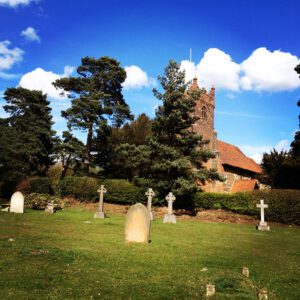 A brief history of Ingatestone & Fryerning
A brief history of Ingatestone & Fryerning
The villages of Ingatestone & Fryerning in Essex are located between Brentwood and Chelmsford. Despite a population of nearly 5,000 and rail and road links to London and the north, the area retains a rural atmosphere and the villages are surrounded by Green Belt, farmland, ancient hedgerows and woods.
Fryerning is the smaller village and, apart from some changes to properties, has remained largely unchanged for many years. The network of public footpaths and bridleways makes it easy to enjoy this picturesque area. Ingatestone is the larger village containing shops for most needs, churches, schools, doctor’s surgery, library, post office, railway station, pubs and restaurants. There are two conservation areas in Ingatestone containing several listed buildings.
Much of Ingatestone’s land was owned by Barking Abbey, a powerful religious house, from Saxon times until the dissolution of the monasteries in 1539 when the land was acquired by Sir William Petre. Sir William was an influential adviser to King Henry VIII, Edward VI, Mary and Elizabeth I. He built Ingatestone Hall, now open to the public: a fine Tudor home which is largely unchanged and is distinguished by an unusual one handed clock on its clock tower.
The name Ingatestone had its origins in Saxon times, when ‘ing’ meant people or settlement. Therefore Ingatestone would have meant ‘people or settlement at the stones’. The High Street stones are unique to the area, believed to have been deposited during the Ice Age.
Ownership of the manor of Fryerning passed through several hands until it was bought by Nicolas Wadham in 1607. He was the founder of Wadham College, Oxford and on his death Fryerning passed into college ownership, where much of it still remains.
The parishes, astride the Essex Great Road, a major route between London and Colchester since Roman times, were prosperous because of the coach and carriage trade. Originally little more than a track, the road increased in importance as people began to move around the country. Ingatestone was a day’s horse ride from London and became a popular place to stop for the night. There were 27 inns in the village, compared to 4 pubs today.
This prosperity continued until the coming of the railways in 1843, and the electrification of the line in 1956 brought a faster and more regular service to Ingatestone. This attracted many new people into the village and new houses were built to accommodate them.
As with many villages, the oldest building is the church, St Edmund and St Mary, fronted by a large sloping lawn onto the High Street, is a fine example of Norman architecture, built over 900 years ago.
Ingatestone High Street was one of the first Conservation Areas to be designated in Essex in 1969.






